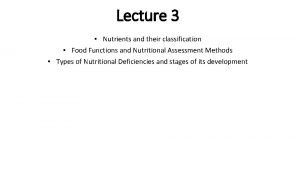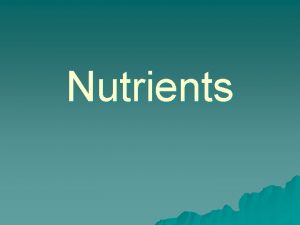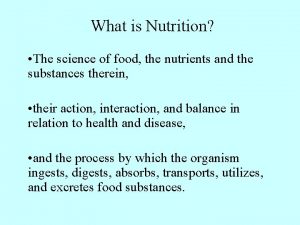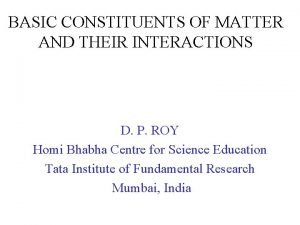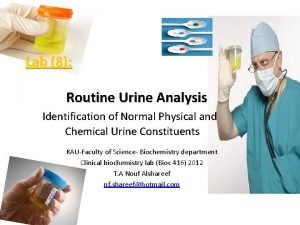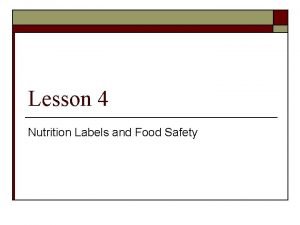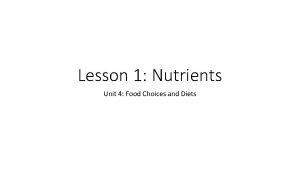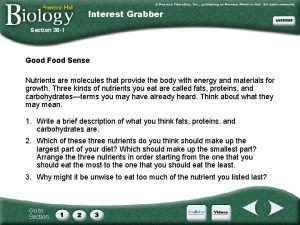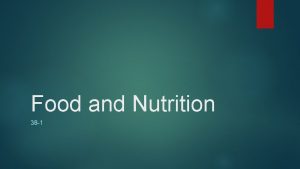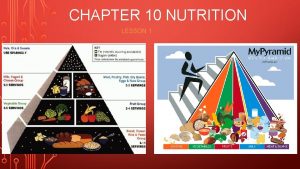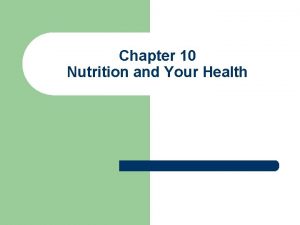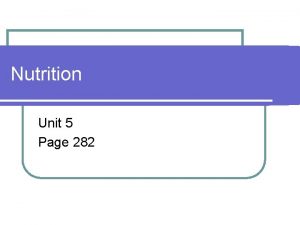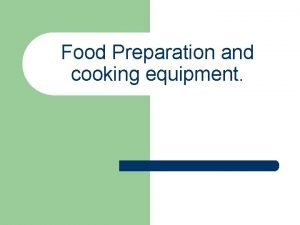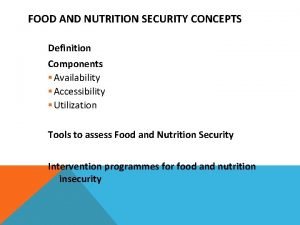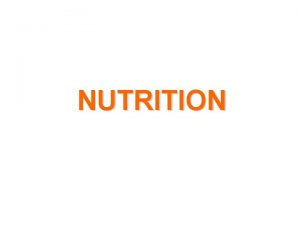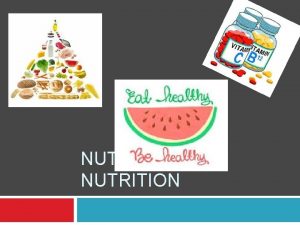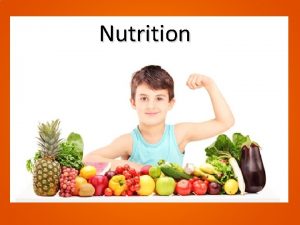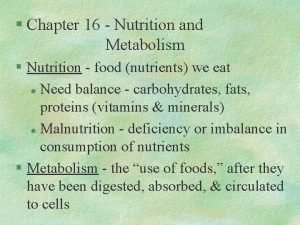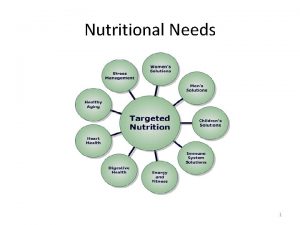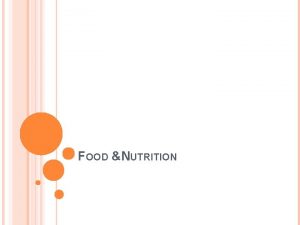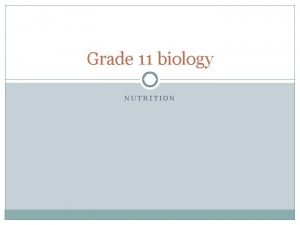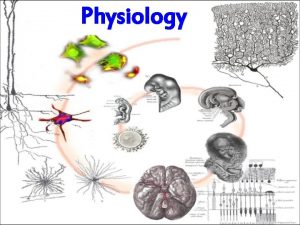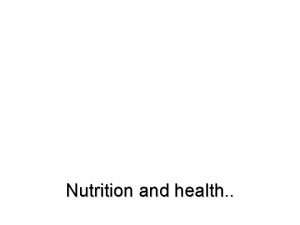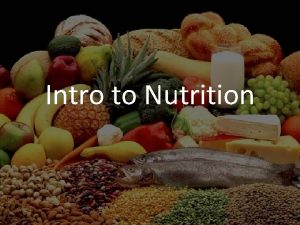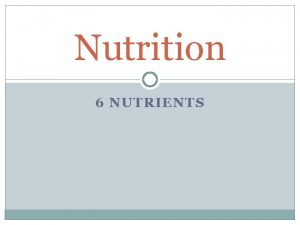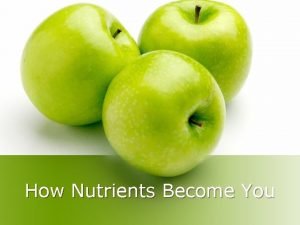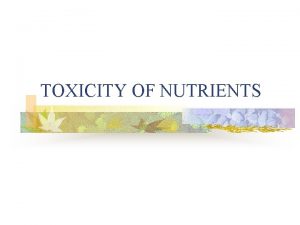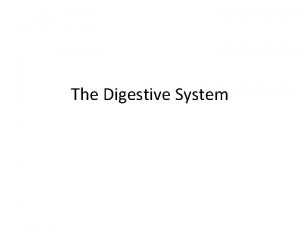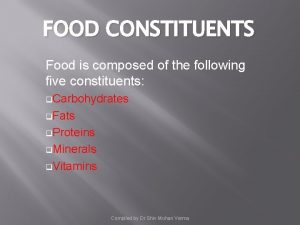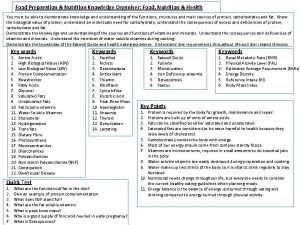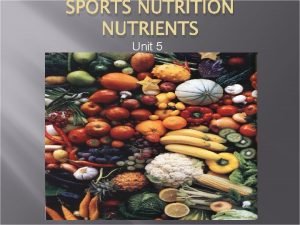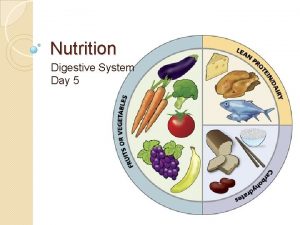Nutrition Nutrients are the constituents of food necessary


































- Slides: 34

Nutrition Nutrients are the constituents of food necessary to sustain the normal functions of the body. All energy is provided by three classes of nutrients: fats, carbohydrates, protein, and in some diets, ethanol. The intake of these energy-rich molecules is larger than that of the other dietary nutrients. Therefore, they are called the macronutrients. This lecture focus on the kinds and amounts of macronutrients that are needed to maintain optimal health and prevent chronic disease in adults. Those nutrients needed in lesser amounts, such as vitamins and minerals, are called the micronutrients are also mentioned.

Learning Objectives 1. How Are the Metabolic Pathways Connected? 2. How Can Biochemistry Help Us Understand Nutrition? 3. What Are Hormones and Second Messengers? 4. How Are Hormones Involved in the Control of Metabolism? 5. What Are the Many Effects of Insulin?

Fig. 24 -1, p. 663

p. 664

Table 24 -1, p. 665

Table 24 -2, p. 666

In humans, the choice of diet becomes important in the interest of obtaining enough of essential nutrients while avoiding excesses of others, such as saturated fats, where excess is known to play a role in the development of health problems. In 1992, a food guide pyramid was published to explain nutrition basics to the public.

Fig. 24 -2, p. 668

The previous pyramid is currently being replaced by a newer version that recognizes the differences between various types of fats and carbohydrates instead of just sending the message that all fats are bad and all carbohydrates are good.

Fig. 24 -3, p. 669

Leptin is a hormone that affects metabolism. It affects the brain to suppress appetite and it affects metabolism directly by stimulating fatty acid oxidation and inhibiting fatty acid synthesis.

Leptin is a protein that's made in the fat cells, circulates in the bloodstream, and goes to the brain. "Leptin is the way your fat cells tell your brain that your energy thermostat is set right, " Leptin tells your brain that you have enough energy stored in your fat cells to engage in normal, relatively expensive metabolic processes, “ like exercise.

Leptin activates AMPdependent pro- tein kinase (AMPK), which regulates many aspects of fuel metabolism. Fig. 24 -4, p. 670

Fig. 24 -5, p. 671

Fig. 24 -6, p. 671

Table 24 -3, p. 672

Fig. 24 -7, p. 673

Fig. 24 -8, p. 674

Fig. 24 -9 a, p. 675

Fig. 24 -9 b, p. 675

Fig. 24 -10, p. 676

p. 676

Fig. 24 -11, p. 677

Fig. 24 -12 a, p. 678

Fig. 24 -12 b, p. 678

epidermal growth factor fibroblast growth factor Fig. 24 -13, p. 679

p. 681

Fig. 24 -14, p. 682

Fig. 24 -15, p. 683

Fig. 24 -16, p. 684

Fig. 24 -17, p. 685

Table 24 -4, p. 685

It has been shown that the GLUT 4 transporter responds to physical activity. When a person is active, the transporter is active and responds well to insulin. After a few days of detraining, this transporter shows only half of the activity it did before. GLUT 4 is one of the glucose transporters on muscle cells. It responds to insulin to move glucose out of the blood and into the cell. In type II diabetes, insulin is present, but does not have the same effect. It takes more insulin to accomplish the same movement out of the blood and into the cell. People with type II diabetes often show classical signs of obesity, and there is a correlation between diminishing GLUT 4 activity, obesity, and diabetes.

END L 29
 Mikael ferm
Mikael ferm Chapter 10 lesson 2 nutrients
Chapter 10 lesson 2 nutrients Macronutirients
Macronutirients The life-sustaining substances in food are called
The life-sustaining substances in food are called The science of food the nutrients and substances therein
The science of food the nutrients and substances therein Definition of food nutrients
Definition of food nutrients Dadhicha system
Dadhicha system Sentence analysis practice
Sentence analysis practice Components of soil diagram
Components of soil diagram Basic constituents of matter
Basic constituents of matter What are the three constituents of the indian parliament
What are the three constituents of the indian parliament How agents, constituents and audiences change negotiations?
How agents, constituents and audiences change negotiations? Csf constituents
Csf constituents What are constituents
What are constituents Composition of urine slideshare
Composition of urine slideshare Normal and abnormal constituents of urine
Normal and abnormal constituents of urine Nephron urinary system
Nephron urinary system Urinalysis result interpretation chart
Urinalysis result interpretation chart Exercise 44
Exercise 44 Epra index constituents
Epra index constituents Unit 2 food food food
Unit 2 food food food Food chain sequence
Food chain sequence Illuminate aqa food preparation and nutrition
Illuminate aqa food preparation and nutrition Lesson 4 nutrition labels and food safety
Lesson 4 nutrition labels and food safety Food and nutrition unit 4
Food and nutrition unit 4 38-2 the process of digestion
38-2 the process of digestion Rda food label
Rda food label Section 38-1 food and nutrition
Section 38-1 food and nutrition Extroidinairre
Extroidinairre Chapter 10 lesson 4 nutrition labels and food safety
Chapter 10 lesson 4 nutrition labels and food safety Chapter 10 lesson 4 nutrition labels and food safety
Chapter 10 lesson 4 nutrition labels and food safety Usda food and nutrition service
Usda food and nutrition service Food and nutrition unit 5
Food and nutrition unit 5 Advantages of labour saving devices
Advantages of labour saving devices Nutrition security meaning
Nutrition security meaning


